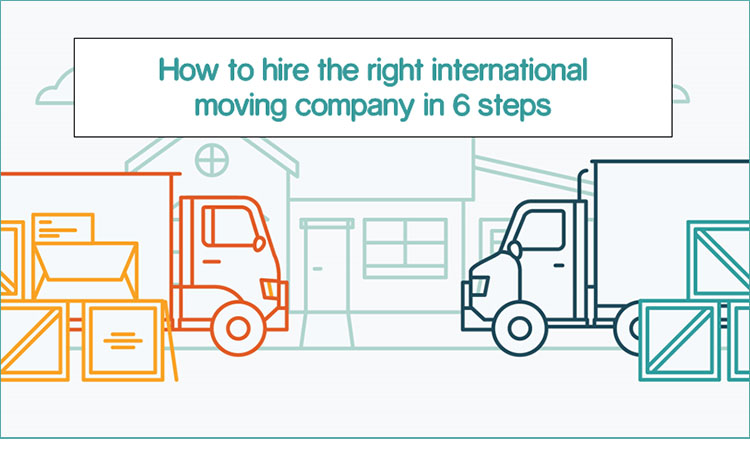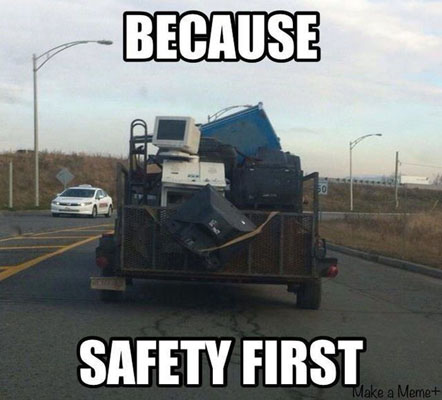
Welcome to the world of international moving Hiring an International Mover
Taking the leap into expat life is an exciting time. Whether you’re moving abroad for work, education, retirement, or just in need of a change of lifestyle, it’s an experience that will stick with you for the rest of your life.
Until teleporting is invented and visas are no longer required, there are quite a few logistical challenges to moving to a new country. One of the biggest is moving your stuff – you know…furniture, dishware, clothing, books…all the things that make a home a home.
Moving all your belongings overseas can be expensive, so before you go down the path of hiring a mover you should decide whether you need to take it all. For some countries, it might be cheaper to sell most of your things and just buy everything new in your destination. On the other hand, if you’re moving to a more expensive country, then shipping everything might be a less expensive option.
If you do decide to ship your things overseas, our step-by-step guide to selecting and hiring the right international moving company will put you on the path to success.
Step 1: Research several moving companies
No one ever really wants to do the research. They simply want to push a button on a website and get a bunch of quick quotes.
However, this is a quick way to disappointment down the road. Many times, this will lead you to untrustworthy companies. Or, even if you find a good company, you’ll typically get an inaccurate quote since they haven’t been able to do an in-home survey.
You need to spend time doing your own research first! Your research process to finding a reputable moving company should include the following:
Make sure the company is part of an industry organization
Is your moving company a part of industry organizations like FIDI, AMSA, or BAR? While these organizations have varying levels of requirements for joining, they are a first step towards vetting your mover.
A word of caution: some mover websites will display an organization logo, but just because the mover’s website has the logo displayed doesn’t necessarily mean they’re a member. Some movers are so dishonest they’ll display it even if they’re not a member (You can see an example of this with our blog post Fake Reviews 2.0: Yelp’s Algorithm is Broken).
Always go to the relevant industry organization’s website and do a search in the membership directory.
Don’t rely too much on customer reviews
Looking at reviews has become a standard part of our lives when evaluating a business we haven’t used before. But when it comes to finding international movers it’s not so straightforward.
There are lots of companies out there that are very good at tricking Yelp (and other review sites) with fake reviews. We’ve gone into the details of this with another blog post on fake reviews and why they can’t be trusted.

Look for companies that have been in business for a while
New moving companies deserve a chance, of course, but the challenge with a new company is there’s no track record to verify. When a company has been in business a while you can usually assume they’re doing decent work.
Be careful here as well: unless the company is obviously a large, established business, you shouldn’t always trust the company website’s account of how old the company is. We’ve seen dishonest companies lie about that stuff, too.
If you’re not sure, you can look up the business on your city/state/country’s business registration site.
Make sure the company is licensed
Is the moving company licensed? This is an important question to ask and will help determine if the moving company you are vetting is a legitimate company and legally allowed to operate.
Ask for their license number and the licensing organization.
Different countries have different regulations but here in the United States, you can check the license through the Department of Transportation (DOT) website where you can access a complete database of licensed moving companies. Another good resource here in the United States is the Federal Maritime Commission (FMC) website. Both allow you to search via company name.
Step 2: Request an in-home survey
After you’ve done your research and found reputable movers, you are now ready to request your in-home surveys from these movers.
Too many times, individuals want to bypass this step because it’s time-consuming: you’ve got to schedule a visit that works for you and the moving company salesperson and walk through your home together pointing out everything you’re going to ship.
But it’s an important part of the process. This will allow the moving company to properly assess your shipment, assess the ease of access to your home, and help you get a more accurate moving quote.
Don’t forget that this is an important time for you, too! The survey gives you an opportunity to evaluate the moving company. Were they on time? How was the customer service? Were they professional?
These in-home surveys can take about 30 minutes to an hour so plan accordingly and have any additional questions written down so you remember to ask the person. Taking the time to go through an in-home survey with your mover is the easiest way to eliminate moving problems further down the road.
(For big moves we always recommend an in-home survey, but if you’ve got a smaller move you might be okay doing a survey over the phone or online.)
Step 3: Compare moving quotes
As with any expensive purchase, you want to compare several providers to make sure you’re getting the best price. When moving abroad, we recommend getting quotes from at least 3 moving companies.
Some people think they need to get quotes from tons of movers, but there’s no need to go overboard. More is not better and if you’ve only contacted reputable movers then the quotes should be roughly similar.
After getting 3-5 quotes from reputable international moving companies, it’s time to compare them to see which one is the best fit. This step is very important, which is why we at GoodMigrations have built a quote comparison feature in our quote request tool.
Keep in mind though that just because a quote is more expensive doesn’t mean it’s not the best company – the cheaper one may not be offering as many moving services, so be sure to look at what’s included in your estimate as well as whats being left out.
Here are some things to watch out for and questions to ask your prospective international moving company if it’s not obvious:
Are the companies quoting the same volume or weight?
This one can be tricky because some overseas movers use volume to create an estimate and some use weight. But when the same methods are being used, you should see if they’re similar. It’s okay if they’re different, but if one is 500 cubic feet and one is 700 cubic feet then you can ask the mover with the lower volume to provide another quote at the higher volume.
This will ensure that you if the first mover underestimated your shipment size you won’t get surprised with a higher cost later.
Is the mode of shipping the same?
Depending on the country you’re moving to and how much money you’ve got to spend on the move, there are options for how your things are actually transported that can make a big difference in price.
- Land: Truck and rail are the two main types of shipping by land. This is obviously an option for non-ocean crossing shipments only. The cost and speed are both moderate.
- Sea Freight: Also known as container shipping, this is the cheapest way to ship internationally but is also the slowest. Depending on the route this could take anywhere from several days to several months
- Air Freight: This shipping method is by far the fastest and most expensive way to ship. An air shipment can cost 10x that of a sea freight. Unless cost is not important and timing is urgent, it is highly recommended to use bulk shipping via sea freight. The main benefit here is speed: you’ll get your things very quickly.
Is the same size shipping container being used for the estimate?
There are two main shipping container options: 20 feet long and 40 feet long. Be aware of the size of your shipment and what shipping container is best for your move. This is something to discuss with your movers should you get quoted in different sizes.
Is your shipment being grouped with others?
If your stuff fills an entire shipping container on its own then it’s referred to as a Full Container Load (FCL). If you don’t have enough stuff to fill an entire container then you would ship a Less Than Container Load, or LCL.
This means that since you can’t fill the whole container, you’ll share it with other shipments so you won’t have to pay for the entire container’s cost. This is also called groupage or consolidation because your stuff will share a container with other shipments to save costs.
While groupage is more affordable, it can have a big impact on the time it takes to reach your destination since your stuff could sit around in a warehouse until the mover has another shipment going to the exact same location.
This can take days, weeks, or months depending on the time of year and where you’re going. If you’re moving in summer that is considered peak moving season, so typically you won’t be waiting as long.
What is the estimated transit time from the date the movers pack up and load your stuff?
It’s frustrating not to have your own furniture, pots and pans, and all the other things you packed and shipped from home. It’s also expensive to stay in temporary furnished housing while you wait for this stuff to arrive.
Because of this, you need to pay close attention to the estimated transit time the movers provide. One mover may be cheaper but take longer – perhaps it’s worth going with the more expensive mover to get your things faster. Keep in mind that transit time starts from when it leaves the the port not from pickup.

Is the quote for door-to-door service?
Be sure the quote is not for “door-to-port” delivery, unless you specifically asked for this. Anything other than door-to-door allows the mover to offer a less expensive quote to beat out the competition.
However, what they may forget to mention is that this means you will have to clear your goods through customs instead. So in the end, you will be navigating customs in a foreign country and be responsible for all the paperwork and fees. Does that sound fun? Didn’t think so.

Are Terminal Handling Charges (THC) and Destination Terminal Handling Charges (DTHC) included?
This is one that catches expats off guard a lot if it’s not mentioned in the quote. Ports charge cargo ships to use their terminals and those charges are distributed among the customers occupying space on that cargo ship.
If these charges are not included in the quote, they can add up to several hundred dollars in additional cost. Even reputable companies don’t always call out if these fees are included.
Will there be any custom crating for special items?
If you’re shipping valuable artwork or antique furniture or anything you want to be extra protected, the moving company may decide a custom crate is needed. This is an additional charge.
Is the quote binding?
If the quote is binding, it means the price quoted will not change unless you decide to ship additional items that weren’t in the initial inventory.
If it’s not binding, it means the cost could change if once the movers pick up your stuff and take it back to the warehouse to measure the volume more accurately. If the shipment is bigger than they though, the price can go up. Costs can change for a variety of other reasons, like the cost of fuel rising.
Step 4: Book your move!

I think Robocop means “Book your move”. And calling people creeps isn’t very nice, Robo!
After the home surveys are complete, it’s time to choose your mover! If you’ve followed all our steps and asked all the right questions, then you should have an easy decision to make.
The biggest mistake we see at this point in the process is focusing exclusively on price and not fully considering the moving services included or the transit time.
At the end of the day, we can’t stress enough how important it is not to focus on price alone. Don’t be penny wise and pound foolish, as they say.
The other big mistake we see is procrastination. Do not wait to book! During peak season, which is typically April through September in the northern hemisphere, many movers book up weeks or months in advance. If you expect to move on a specific day or week, do not wait. Get it booked and get it on the calendar. You can always change your date later if you really need to.
When you do book, you may be asked for a down payment. You’ll owe the balance of the cost after the movers pick up your stuff, but before it actually ships out.
Step 5: Insure your stuff
Things happen during an international move: a box gets dropped, or a box gets lost, or clothing and furniture sitting in a humid warehouse get moldy. Because of these risks you need to insure your shipment.

Insurance is rarely included in the quote the mover provides but is always available so be sure to ask if they haven’t already brought it up. The mover isn’t your only option for insurance; some third party insurance providers offer international moving insurance as well.
If insurance is the kind of thing that gets you really excited (isn’t that everybody J), you can get more tips on insuring your things.
Step 6: Completing the move
It’s finally here, the day you’ve been anxiously waiting for…delivery day! You’ve been patiently waiting for your stuff to arrive, but it’s not over just yet.
You should be present when the movers come to deliver your shipment. And you should have a copy of the inventory sheet available so that you and the delivery people can mark off the inventory as it gets brought inside.
Making sure all your belongings are there is obviously important. However, it’s equally important that you personally check your items for any damages. When the movers are done unloading everything they’ll ask you to sign a document that says everything is accounted for and undamaged.

Even Rick Astley uses checklists to make sure he’s got everything covered.
You won’t have time to unpack all your boxes, of course, but do a quick look over all of them to check for any signs of damage on the outside. Inspect the boxes that you suspect might have been compromised. Furniture is easier to assess – you want to look for any cracks or breaks, tears in fabric, or signs of mold.
Should you find any significant damage to your belongings, be sure to make it known to the delivery people and have them document this. Most likely they will not have a claim form on them but be sure to contact your insurer and notify them so you can file a claim.
A typical window for submitting claims is approximately 30 days after delivery, but this can vary with each company, so be sure to act fast if you do need to submit a claim.
* * *
We hope that this guide to hiring an international moving company helps you with your move abroad. If you’re ready to request quotes and compare reputable companies, feel free to request a quote through our secure platform and we’ll be there every step of the way to help.
Or, for more information on moving internationally, check out our Ultimate Guide to Moving Abroad.
Happy moving!